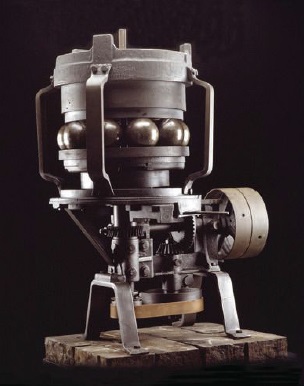Tribology—The great enabler
Edward P. Salek, CAE, Executive Director | TLT Headquarters Report March 2013
130 years later, the remarkable Kugelmühle still has a story to tell.

Kugelmühle — ball grinding machine.
THE TECHNICAL PROGRAM for the 2013 STLE Annual Meeting in Detroit this May includes nearly 50 presentations dealing with some aspect of bearing design, performance and lubrication. When you combine that with a panel discussion and education course on the same subject, it amounts to roughly 20% of the conference program.
In late January STLE professional development director Bob Gresham and I visited the Bavarian city of Schweinfurt, which many people regard as the birthplace of modern bearing technology. It’s also the home of Schaeffler Technologies AG, which develops and manufactures bearings and other precision products under the INA, LuK and FAG brands. Our host was STLE director Dr. Vasilios Bakolas, Schaeffler’s Manager Bearing Basics, who gave us a thorough look at the past, present and future of this critical mechanical component.
During our facility tour, we encountered an unfamiliar device known as a Kugelfischer ball grinding machine (Kugelmühle). Its history dates back to 1883, which was when a Schweinfurt mechanic named Friedrich Fischer invented the machine to allow grinding large volumes of hardened steel balls to absolute roundness. This innovation, a breakthrough technology of its day, proved to be the foundation for a ball bearing success story and for the FAG company, still a world leader in the bearing industry.
Although he didn’t know it at the time, since the word tribology was still some 80 years in the future, Fischer was using the science of surface engineering to enable a technology that’s still going strong, as evidenced by the amount of attention bearings are getting at the 2013 STLE conference. But the interesting tale of the Kugelmühle does not end in Schweinfurt.
The day after our tour at Schaeffler, Bob and I visited the famous Deutsches Museum in Munich prior to our return to the United States. The museum’s collections include more than 100,000 objects from the fields of science and technology. It is regarded as one of the most important scientific and technical museums in the world.
As we made our way through the museum, a fortuitous climb up a set of back stairs led us to a collection of mechanical engineering displays that included an original Kugelmühle. While we knew the importance of this 19th Century engineering wonder, it’s a safe bet that few other visitors that day, or any other day, put this on their list of must-see attractions. Instead, visitors flock to areas of the museum with newer and more engaging exhibits featuring robotics, genetic engineering and nanotechnology.
Now that I’ve had some time to think about the museum visit, it’s clear that there’s a lesson to be learned. A case can be made for the fact that this humble machine, and the bearing industry it helped create, was the foundational technology that has made many of the other scientific and engineering marvels that are on display at the museum a reality.
The Kugelmühle exhibit demonstrates the need for organizations like STLE to not just speak to each other, as we do at the annual meeting. We also must make sure that the scientific and engineering community, policy makers and the general public are aware of the fact that tribology and lubrication engineering can be an enabler for future technical breakthroughs.
This is not an easy task. To get things started, a scale model of the Kugelmühle (a gift to the society from Schaeffler) now sits proudly in the STLE lobby. It has become a great conversation-starter with visitors. More important, it is a reminder that STLE and its members play a vital role as communicators and advocates for the tribology and lubrication engineering communities.
 You can reach Certified Association Executive Ed Salek at esalek@stle.org
You can reach Certified Association Executive Ed Salek at esalek@stle.org.